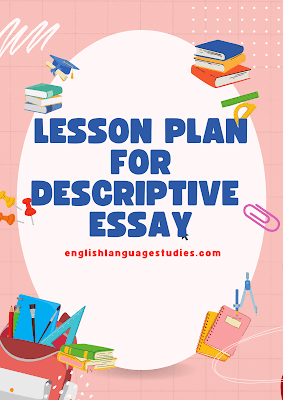Introduction:
Descriptive writing is the art of painting vivid images with words. Whether students are describing a person, a place, or a memory, this genre strengthens their ability to observe, imagine, and communicate in detail. Here’s a tried-and-tested lesson plan to help your students master the skill of writing a descriptive essay.
Lesson Plan: Descriptive Essay Writing
Grade Level: 8–10
Subject: English Language / Writing Skills
Duration: 2–3 class periods (40–50 minutes each)
Topic: Writing a Descriptive Essay
Objective:
By the end of the lesson, students will be able to:
- Identify the elements of a good descriptive essay
- Use sensory details and figurative language
- Plan, draft, and revise their own descriptive essays
Warm-up Activity: “Show, Don’t Tell” (10–15 minutes)
Instructions:
Write the sentence: “The cake was delicious.” on the board.
Ask students: “How can we SHOW this instead of just TELLING it?”
Guide them to describe the taste, smell, texture, and appearance of the cake.
Example:
“Warm chocolate oozed out as I sliced through the soft sponge, its sweet aroma pulling me in like a magnet. The first bite melted in my mouth, sending waves of sugary delight down my spine.”
Purpose:
This exercise sets the tone for the power of sensory language in descriptive writing.
Main Lesson: What Makes a Descriptive Essay? (15–20 minutes)
Step 1: Discuss Features
Write these on the board and explain briefly:
- Vivid sensory details (sight, sound, touch, taste, smell)
- Figurative language (similes, metaphors, personification)
- Organization (spatial order or logical flow)
- Strong focus on a central theme or feeling
Step 2: Sample Essay Analysis
Give students a short descriptive essay.
As a class, highlight:
- Sensory details
- Figurative language
- Structure
Discussion Questions:
- What stands out in the description?
- What emotion or atmosphere does the writer create?
- How is the essay organized?
Guided Practice: Planning the Essay (20–25 minutes)
Prompt Options:
- Describe your favorite place in nature.
- Describe a person who inspires you.
- Describe a memory that you’ll never forget.
Planning Worksheet:
Have students brainstorm using a five-senses chart:
Sense Details
Sight
Sound
Smell
Taste
Touch
Tip: Encourage them to use similes and metaphors in their planning.
Independent Writing: Drafting the Essay (30–40 minutes)
Give students time to write their first draft. Encourage:
- A strong opening paragraph
- Well-organized body paragraphs
- A reflective or impactful conclusion
Peer Review & Editing (20 minutes)
Checklist for peer review:
- Is the essay focused on one main subject?
- Are there enough sensory details?
- Is the language vivid and descriptive?
- Does the essay have a clear structure?
Pairs read and give feedback using the checklist.
Homework / Extension Activity:
Ask students to revise their drafts based on peer feedback and submit a final typed version.
Optional: Turn the final essays into a class magazine or blog post!
Assessment Criteria:
Final Thoughts:
Descriptive essays allow students to channel their creativity while enhancing their writing technique. This lesson not only improves their ability to describe but also helps them develop a keen eye for observation—a vital skill for all forms of writing.
Happy teaching!
Let me know in the comments how you teach descriptive essays.
Lesson Plan: Nouns for A1 and A2 Levels
Lesson Plan: Pronouns for A1 and A2 Levels
